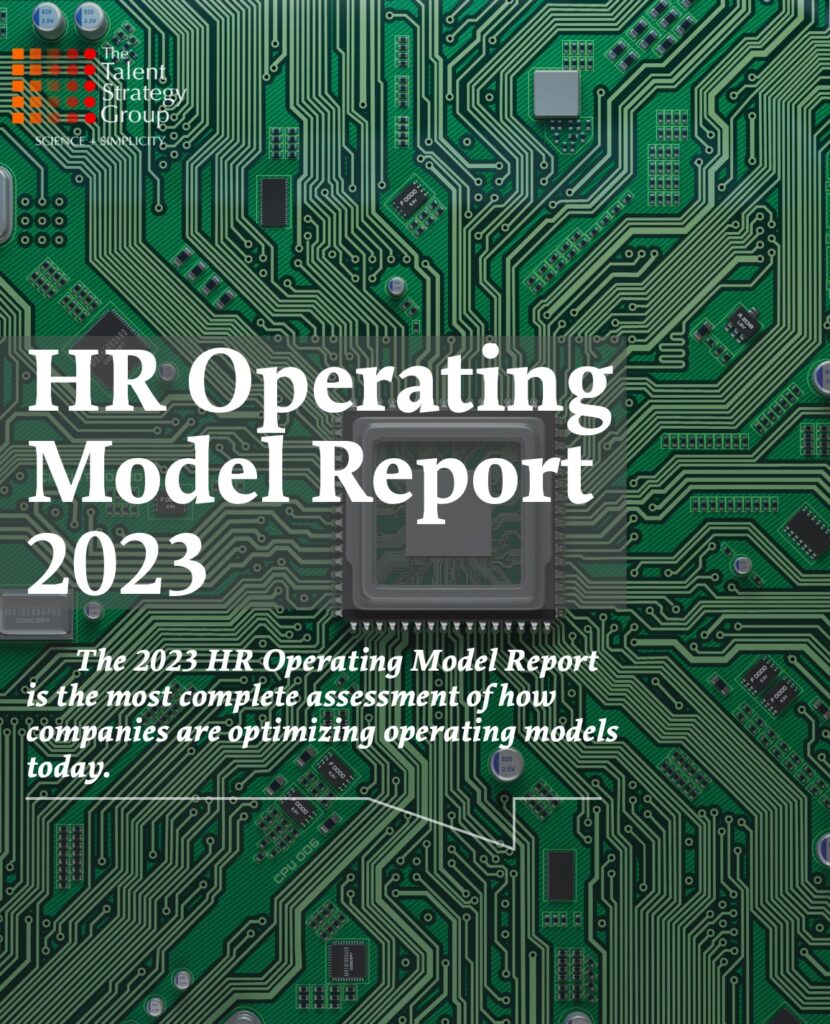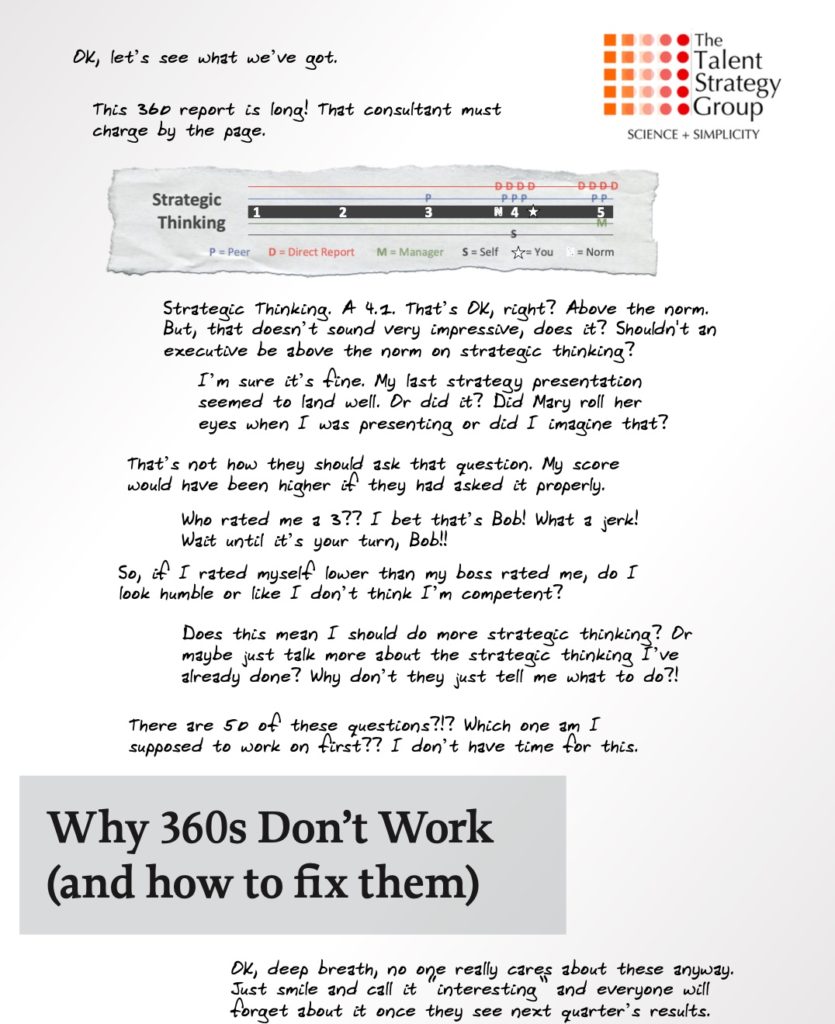Please enter your email in order to download this publication.
Goals: Fewer. Bigger. Stronger.
When we see a client’s failing performance management process, our first question is about how goal setting works in the organization.
The client will say that goals are set 5 months into the year. They’ll show us long lists of tactical goals. They’ll explain that managers have no accountability to set goals well.
While those answers are no longer surprising, they underscore the essential truth of performance management: If great goals are not set, nothing else matters.
Start with the Science
The science is clear. If you want higher performance in your organization, set great goals. That science tells us that:
- Goals deliver better results than no goals: It’s a bit intuitive but it’s also been tested and proven that giving someone a specific goal results in higher performance than merely asking them to “do their best.” In short, goals motivate performance.1
- Bigger goals create bigger results: Individuals respond to additional challenge with additional effort, so every goal should be set to the maximum reasonable level of stretch.2 Most goal setting leaves performance “on the table” because we aren’t challenging employees to high enough performance. A bigger goal does not translate into more hours worked, just more focus on the few things that matter most.
- It doesn’t matter who sets the goal (kind of): People will deliver similar results whether they set their own goals or someone sets their goals for them. In theory, this means that it shouldn’t matter who starts the goal setting process, but we have a strong preference for managers to lead this process and we describe why below.3
Set a Strong Foundation
We strongly recommend that you have your Talent Philosophy in place before designing performance management. A talent philosophy is your executive team’s beliefs about how talent should be managed to achieve the business strategy.
That philosophy will provide clarity on important topics like how much behaviors matter, how much we differentiate results and more. You can learn more about talent philosophy here.
Set Great Goals
Setting brilliant goals takes effort but it’s well within the capability of every one of your managers. Here’s how to make it happen:
1. Get Aligned
Many managers believe that employees should set their own goals, and they ascribe any number of benefits to that choice from more motivation and better task alignment to higher performance. As we mentioned earlier the science is clear that who sets the goals does not matter.
Our point of view is that managers are best positioned to both translate requirements from the level above them to the level below them and to set goals with greater stretch than the employee would naturally include. For that reason, we recommend manager-led goal setting to ensure alignment and stretch.
Manager-led means clarifying for direct reports the three or four large goals for the group and asking the employees to identify three or four big commitments they’ll make to achieve those goals. It doesn’t mean that the manager tells their direct reports exactly what their goals should be.
2. Make them Fewer and Bigger
In too many organizations, employees’ goals resemble project plans, task lists or job descriptions, not the few, largest contributions they can make to the company’s success. Since we know that bigger goals get better results, an employee’s goals should represent the most meaningful promises they can make to the company for that performance cycle. You can help managers get there by:
- Set a limit of 1 – 4 goals: We’ve found that limiting the number of goals is the essential starting point for creating great goals. The logic of fewer goals is that, while we’re all busy and working on important things, none of us has more than four truly meaningful deliverables to give the company in a year. Identifying those few things provides clarity and direction.
It doesn’t mean there aren’t other important objectives to accomplish. It simply says that these are the contributions that will provide the company with the largest benefits that year.
- Prioritize: Getting to a few goals typically requires employees to prioritize and combine their activities into fewer, more meaningful objectives. Two helpful tactics for prioritizing are:
- Compress activities: It’s easy to become so focused on project plans or big activities that we lose sight of the true objective that employees are trying to achieve. Compressing goals involves combining smaller goals or activities into a larger, more meaningful and potentially impactful goal.
Sometimes that means asking “What’s the largest possible benefit these activities could deliver?” or “What’s the ultimate outcome that you’re trying to reach with these activities?”. Employees sometimes resist this activity because they want credit for activity (even big activity) rather than results.
Your job as a manager is to elevate their thinking to help them see the metrics and achievements that truly matter.
-
- Rank: Ranking goals allows you to take a list of important goals and identify the top three or four. The key question to ask when faced with a list of 10 – 12 goals is “Which of these goals represents the largest performance promise you can make to our organization this year?” or “Which of these goals will have the largest positive impact on the business strategy?”
3. Radically simplify
Taking work and distractions out of the goal setting process makes the manager’s job easier and makes HR look more competent and business-focused. A few things that can quickly simplify the process are:
- No behavioral goals: If you take one of your three or four goals and assign it to a behavior, you’re saying that improving a behavior is more important than any other performance goal that could be set.
Our perspective is that if behaviors need to improve, that can be stated without making it a goal. Many organizations formally incorporate behaviors into the review process, so there’s a specific opportunity to hold employees accountable for behaviors at review time. - No weighting: Don’t allow managers to indicate how important a goal is by giving it a specific weighting (i.e. 24%, 40%). That adds complexity with absolutely no value. Goals may change in importance during the performance period. That invalidates weighting. Weighting also implies that calculating performance will be a formulaic exercise, which we strongly advise against. And, it’s quite simple to either list the goals in order of importance or just tell an employee which goal they should prioritize.
- No classification: There’s no benefit to forcing employees to write goals in specific categories because they correspond to a balanced scorecard, the four priorities of the senior team or some other framework. Goals should represent the few, largest contributions an employee promises to make. Those may be all in one category or spread across many, but forcing goals by category suggests that you’re trading off maximizing performance for alignment with an arbitrary framework.
- Be SIMple, not SMART: The classic SMART goal framework isn’t wrong, but you can set a very SMART goal that isn’t the big, meaningful, challenging goal that we described earlier. To reinforce that great goals should only capture the most important things, we prefer to say that goals should be Specific, Important and Measurable – SIMple.
4. Guarantee Great Goal Quality
The steps above will help managers set better goals but you’ll still want to ensure that goal-setting is working well across your organization. We assume that managers will review their direct reports’ goals but also recommend:
- Selectively audit goals: “We don’t want to be the HR police” say HR business partners when we suggest that they audit goals. Our response is “Shine up your badge” because there’s no larger impact that HR can have on the business than helping to drive higher performance.
HR should be goal setting experts and know the business well enough to understand if goals are being set at a reasonable level of stretch and quality. Business partners should read through 10% to 15% of the goals set in their group or division. They should provide helpful, not punitive, feedback to managers about how these goals could be improved. When managers know that someone is paying attention to the quality of the goals they set, they’re likely to pay more attention to quality and stretch.
- Goal Calibration: Goal calibration is a fast and easy process to ensure the goals set by each team member have a relatively similar level of challenge and are aligned against the few big group objectives.
A calibration session can easily be built into a typical team meeting. In the session, each team member reads their three or four goals. The manager listens for a similar level of goal challenge and peers listen for opportunities for collaboration or areas of overlap with their own goals. Goals are adjusted after suggestions from the group.
You can’t correct for poorly set goals during performance reviews, so use these two simple practices to ensure that great goals are set across the organization.
Invest where it matters
Setting great goals is the shortest, surest path to higher organizational performance. Doing it well requires believing that it truly matters and enforcing the discipline of goal setting with every manager in your organization.
- Locke, Edwin A., and Gary P. Latham. A theory of goal setting & task performance. Prentice-Hall, Inc, 1990.
- Ibid.
- Latham, Gary P., Miriam Erez, and Edwin A. Locke. “Resolving scientific disputes by the joint design of crucial experiments by the antagonists: Application to the Erez–Latham dispute regarding participation in goal setting.” Journal of Applied Psychology 73.4 (1988): 753.




